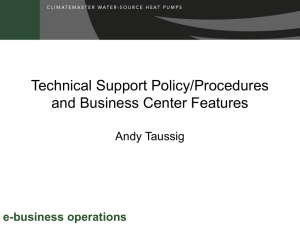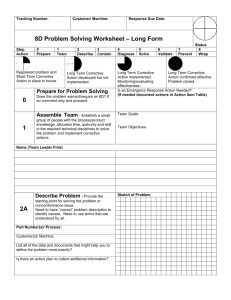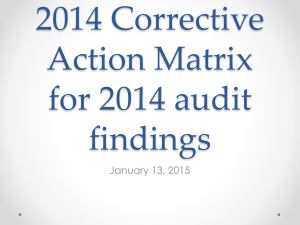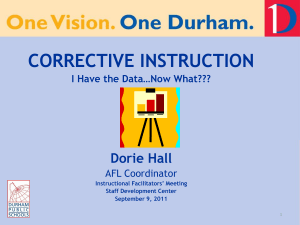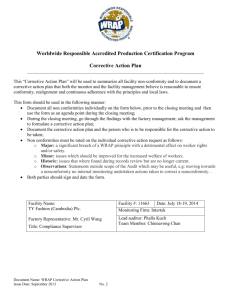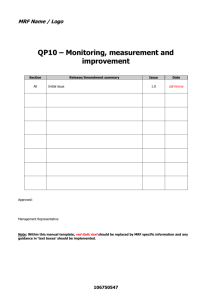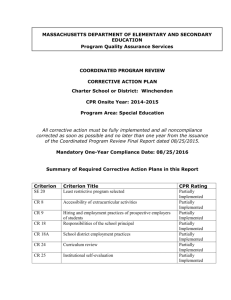Final SACS Analysis - Fayetteville State University
advertisement
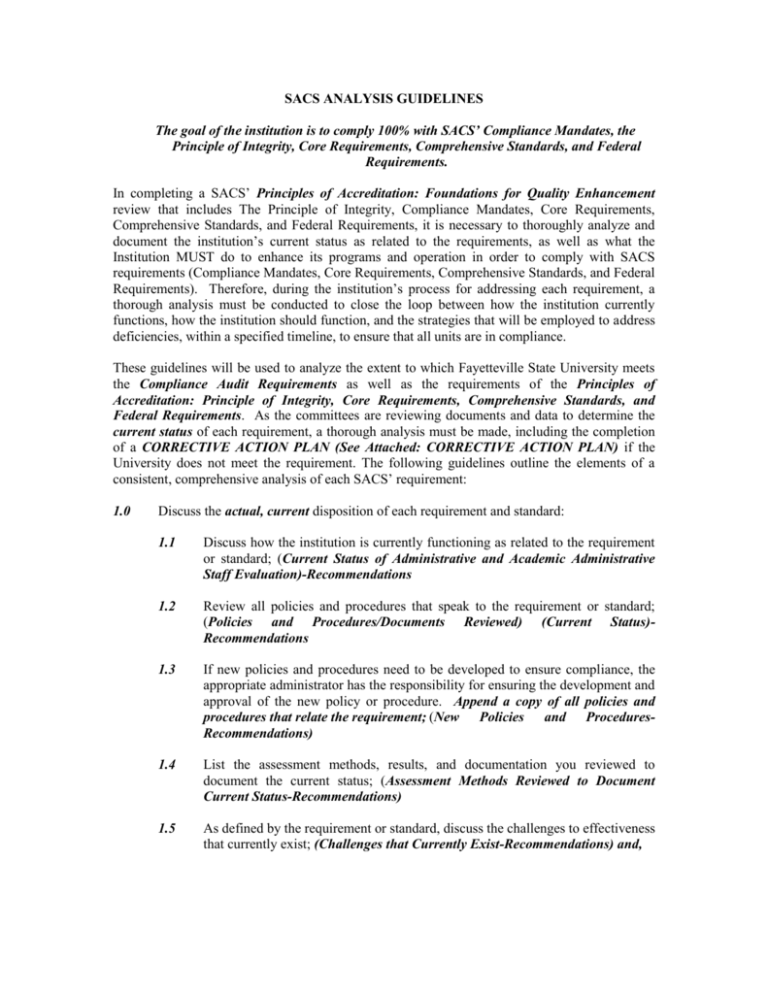
SACS ANALYSIS GUIDELINES The goal of the institution is to comply 100% with SACS’ Compliance Mandates, the Principle of Integrity, Core Requirements, Comprehensive Standards, and Federal Requirements. In completing a SACS’ Principles of Accreditation: Foundations for Quality Enhancement review that includes The Principle of Integrity, Compliance Mandates, Core Requirements, Comprehensive Standards, and Federal Requirements, it is necessary to thoroughly analyze and document the institution’s current status as related to the requirements, as well as what the Institution MUST do to enhance its programs and operation in order to comply with SACS requirements (Compliance Mandates, Core Requirements, Comprehensive Standards, and Federal Requirements). Therefore, during the institution’s process for addressing each requirement, a thorough analysis must be conducted to close the loop between how the institution currently functions, how the institution should function, and the strategies that will be employed to address deficiencies, within a specified timeline, to ensure that all units are in compliance. These guidelines will be used to analyze the extent to which Fayetteville State University meets the Compliance Audit Requirements as well as the requirements of the Principles of Accreditation: Principle of Integrity, Core Requirements, Comprehensive Standards, and Federal Requirements. As the committees are reviewing documents and data to determine the current status of each requirement, a thorough analysis must be made, including the completion of a CORRECTIVE ACTION PLAN (See Attached: CORRECTIVE ACTION PLAN) if the University does not meet the requirement. The following guidelines outline the elements of a consistent, comprehensive analysis of each SACS’ requirement: 1.0 Discuss the actual, current disposition of each requirement and standard: 1.1 Discuss how the institution is currently functioning as related to the requirement or standard; (Current Status of Administrative and Academic Administrative Staff Evaluation)-Recommendations 1.2 Review all policies and procedures that speak to the requirement or standard; (Policies and Procedures/Documents Reviewed) (Current Status)Recommendations 1.3 If new policies and procedures need to be developed to ensure compliance, the appropriate administrator has the responsibility for ensuring the development and approval of the new policy or procedure. Append a copy of all policies and procedures that relate the requirement; (New Policies and ProceduresRecommendations) 1.4 List the assessment methods, results, and documentation you reviewed to document the current status; (Assessment Methods Reviewed to Document Current Status-Recommendations) 1.5 As defined by the requirement or standard, discuss the challenges to effectiveness that currently exist; (Challenges that Currently Exist-Recommendations) and, 1.6 2.0 List the assessment methods, results, and documentation you reviewed to substantiate that these challenges exist. (Methods Used to Verify that These Challenges Exist-Recommendations) Describe each requirement or standard that is not in compliance and design a CORRECTIVE ACTION PLAN to ensure compliance. 2.1 Delineate action steps that must be taken to ameliorate non-compliance, including: Use Attached Form CORRECTIVE ACTION PLAN for 2.1.1-2.1.7) 2.2 2.1.1 Identify requirement of standard that is not in compliance; 2.1.2 Develop action steps, with timelines to address the requirement or standard (**Include in Action Steps the identification of areas of control (internal and external) that affect the institution’s ability to implement the CORRECTIVE ACTION PLAN and develop action steps to ameliorate their influence); 2.1.3 List the resources needed for successful implementation, cost, and funding source of these resources, if applicable; 2.1.4 Identify the individuals responsible for the implementation of each action step; 2.1.5 Discuss the actual methods of assessment employed to determine the effectiveness of discrete action steps and the CORRECTIVE ACTION PLAN as a whole; 2.1.6 List the assessment methods, results, and documentation you reviewed to ascertain that non-compliance still exists; 2.1.7 If non-compliance still exists once the CORRECTIVE ACTION PLAN has been implemented and assessed, describe the additional steps (using the CORRECTIVE ACTION PLAN Form) that must be taken to ensure compliance; Discuss the benefits to the institution as a result of the requirement or standard being in compliance; (Benefits to the Institution) 3.0 Prepare your findings for presentation to the appropriate review committee, including recommendations for further institutional enhancements that must be effected to ensure compliance. 4.0 List all documentation: 4.1 Name of report 4.2 Date of report 4.3 Persons responsible for preparing the report 4.4 Frequency/Timeframe in which reporting is required 4.5 Office in which the hard copy of the report is housed 4.6 Web-site designation that houses the report 5.0 List Data Reviewed 5.1 5.2 5.3 5.4 5.5 Name of data source/survey/assessment Date of generation of data Persons responsible for generating data Frequency/Timeframe in which reporting of data and analysis is required Timeframe after data and analysis are generated when results are available for program planning 5.6 How data and analysis are used for program improvement 5.7 Office in which the data/report is housed 5.8 Web-site designation that houses the data and analysis 6.0 List Recommendations- It is recommended that: 7.0 Final Disposition of the Requirement or Standard 7.1 Requirement or Standard 7.2 Is the University in compliance with, or meets the Requirement? Yes________ No______ If no, did you develop a CORRECTIVE ACTION PLAN? 7.3 If you developed a Corrective Action Plan, when will the action steps be completed to bring the requirement into compliance? 7.4 What is the projected cost to the University? 7.5 Are there challenges to completing the action plan and attaining the outcomes? 7.6 What are your recommended strategies/resolutions to addressing these challenges? 8.0 List References 9.0 List Appendices, number them and include in report 10.0 List committee member’s names, titles, University extensions, and e-mail addresses


